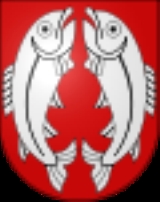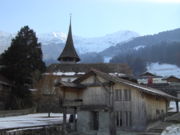
Leissigen
Encyclopedia
Leissigen is a municipality
in the Interlaken-Oberhasli administrative district
in the canton
of Bern in Switzerland
.
personal name Lantgis and the toponymic suffix -ingun, meaning "of the people of Langtis."
 Leissigen has an area, , of 10.36 km² (4 sq mi). Of this area, 3.25 km² (1.3 sq mi) or 31.4% is used for agricultural purposes, while 5.39 km² (2.1 sq mi) or 52.0% is forested. Of the rest of the land, 0.61 km² (0.235522316741446 sq mi) or 5.9% is settled (buildings or roads), 0.1 km² (24.7 acre) or 1.0% is either rivers or lakes and 1.02 km² (0.393824201764386 sq mi) or 9.8% is unproductive land.
Leissigen has an area, , of 10.36 km² (4 sq mi). Of this area, 3.25 km² (1.3 sq mi) or 31.4% is used for agricultural purposes, while 5.39 km² (2.1 sq mi) or 52.0% is forested. Of the rest of the land, 0.61 km² (0.235522316741446 sq mi) or 5.9% is settled (buildings or roads), 0.1 km² (24.7 acre) or 1.0% is either rivers or lakes and 1.02 km² (0.393824201764386 sq mi) or 9.8% is unproductive land.
Of the built up area, housing and buildings made up 3.6% and transportation infrastructure made up 2.2%. 45.8% of the total land area is heavily forested and 2.9% is covered with orchards or small clusters of trees. Of the agricultural land, 13.3% is pastures and 18.1% is used for alpine pastures. All the water in the municipality is in rivers and streams. Of the unproductive areas, 6.6% is unproductive vegetation and 3.3% is too rocky for vegetation.
Leissigen lies in the Bernese Oberland
on Lake Thun
. It includes the village and scattered individual farm houses. It stretchs from the lake shore though woods and into the alps. On the southern border of the municipality lies the Morgenberghorn 2249 m (7,378.6 ft).
Over Leissigen lies the Meielisalp with the scenic restaurant-hotel Meielisalp.
In the 2007 election the most popular party was the SVP
which received 35.9% of the vote. The next three most popular parties were the SPS
(18%), the FDP
(13.2%) and the Green Party
(11.3%).
The age distribution of the population is children and teenagers (0–19 years old) make up 20.9% of the population, while adults (20–64 years old) make up 55.1% and seniors (over 64 years old) make up 23.9%. The entire Swiss population is generally well educated. In Leissigen about 78.5% of the population (between age 25-64) have completed either non-mandatory upper secondary education or additional higher education (either university or a Fachhochschule
).
Leissigen has an unemployment rate of 1.89%. , there were 27 people employed in the primary economic sector and about 12 businesses involved in this sector. 51 people are employed in the secondary sector and there are 15 businesses in this sector. 166 people are employed in the tertiary sector, with 27 businesses in this sector.
The historical population is given in the following table:
Municipalities of Switzerland
Communes , also known as municipalities, are the smallest government division in Switzerland, numbering 2,596 . While many have a population of a few hundred citizens, the largest cities such as Zürich or Geneva also have the legal status of municipalities...
in the Interlaken-Oberhasli administrative district
Interlaken-Oberhasli (administrative district)
Interlaken-Oberhasli District in the Canton of Bern was created on 1 January 2010. It is part of the Oberland administrative region. It contains 29 municipalities with an area of and a population of 48,763....
in the canton
Cantons of Switzerland
The 26 cantons of Switzerland are the member states of the federal state of Switzerland. Each canton was a fully sovereign state with its own borders, army and currency from the Treaty of Westphalia until the establishment of the Swiss federal state in 1848...
of Bern in Switzerland
Switzerland
Switzerland name of one of the Swiss cantons. ; ; ; or ), in its full name the Swiss Confederation , is a federal republic consisting of 26 cantons, with Bern as the seat of the federal authorities. The country is situated in Western Europe,Or Central Europe depending on the definition....
.
Origin of the name
The name Leissigen comes from the Old High GermanOld High German
The term Old High German refers to the earliest stage of the German language and it conventionally covers the period from around 500 to 1050. Coherent written texts do not appear until the second half of the 8th century, and some treat the period before 750 as 'prehistoric' and date the start of...
personal name Lantgis and the toponymic suffix -ingun, meaning "of the people of Langtis."
History
Leissigen is first mentioned in 1285 as Lensengne. In 1290 it was mentioned as Lenxingen.Geography

Of the built up area, housing and buildings made up 3.6% and transportation infrastructure made up 2.2%. 45.8% of the total land area is heavily forested and 2.9% is covered with orchards or small clusters of trees. Of the agricultural land, 13.3% is pastures and 18.1% is used for alpine pastures. All the water in the municipality is in rivers and streams. Of the unproductive areas, 6.6% is unproductive vegetation and 3.3% is too rocky for vegetation.
Leissigen lies in the Bernese Oberland
Bernese Oberland
The Bernese Oberland is the higher part of the canton of Bern, Switzerland, in the southern end of the canton: The area around Lake Thun and Lake Brienz, and the valleys of the Bernese Alps .The flag of the Bernese Oberland consists of a black eagle in a gold field The Bernese Oberland (Bernese...
on Lake Thun
Lake Thun
Lake Thun is an Alpine lake in the Bernese Oberland in Switzerland. It took its name from the city of Thun, on its northern shore.Lake Thun's approximately 2,500 km² large catchment area frequently causes local flooding after heavy rainfalls...
. It includes the village and scattered individual farm houses. It stretchs from the lake shore though woods and into the alps. On the southern border of the municipality lies the Morgenberghorn 2249 m (7,378.6 ft).
Over Leissigen lies the Meielisalp with the scenic restaurant-hotel Meielisalp.
Demographics
Leissigen has a population (as of ) of . , 5.0% of the population was made up of foreign nationals. Over the last 10 years the population has grown at a rate of 9.4%. Most of the population speaks German (93.7%), with Albanian being second most common ( 1.8%) and French being third ( 1.2%).In the 2007 election the most popular party was the SVP
Swiss People's Party
The Swiss People's Party , also known as the Democratic Union of the Centre , is a conservative political party in Switzerland. Chaired by Toni Brunner, but spearheaded by Christoph Blocher, the party is the largest party in the Federal Assembly, with 58 members of the National Council and 6 of...
which received 35.9% of the vote. The next three most popular parties were the SPS
Social Democratic Party of Switzerland
The Social Democratic Party of Switzerland is the largest centre-left political party in Switzerland....
(18%), the FDP
Free Democratic Party of Switzerland
The Free Democratic Party was a classical liberal political party in Switzerland. It was one of the major parties in Switzerland until its merger with the smaller classical liberal Liberal Party, to form FDP.The Liberals on 1 January 2009....
(13.2%) and the Green Party
Green Party of Switzerland
The Green Party of Switzerland is the fifth-largest party in the National Council of Switzerland, and the largest party that is not represented on the Federal Council.-History:...
(11.3%).
The age distribution of the population is children and teenagers (0–19 years old) make up 20.9% of the population, while adults (20–64 years old) make up 55.1% and seniors (over 64 years old) make up 23.9%. The entire Swiss population is generally well educated. In Leissigen about 78.5% of the population (between age 25-64) have completed either non-mandatory upper secondary education or additional higher education (either university or a Fachhochschule
Fachhochschule
A Fachhochschule or University of Applied Sciences is a German type of tertiary education institution, sometimes specialized in certain topical areas . Fachhochschulen were founded in Germany and later adopted by Austria, Liechtenstein, Switzerland and Greece...
).
Leissigen has an unemployment rate of 1.89%. , there were 27 people employed in the primary economic sector and about 12 businesses involved in this sector. 51 people are employed in the secondary sector and there are 15 businesses in this sector. 166 people are employed in the tertiary sector, with 27 businesses in this sector.
The historical population is given in the following table:
| year | population |
|---|---|
| 1764 | 250 |
| 1850 | 416 |
| 1900 | 481 |
| 1930 | 601 |
| 1950 | 625 |
| 1980 | 663 |
| 2000 | 898 |

